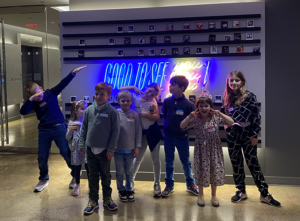Working better together – a lesson for all of us
Ahh, the nostalgia of going to “work” as a kid. I have fond memories of going to my parents’ respective workplaces as a child (then it was Take Your Daughter to Work Day) – going to sales meetings while eating snacks in the car with my dad, “reading” to my mom’s sixth grade class as a second grader. This year, I got to participate in it again. Except this time, I was the mom who brought her six-year-old daughter to work.
Thursday, April 27th was “Take a Kid to Work Day” – an annual event celebrated across the nation. So popular even the White House participated. This year’s theme, “Working Better Together,” focused on inspiring youth to consider how collaboration and cooperation skills will enhance their future careers. To me, this theme couldn’t be more timely given the state of the world and the shifts we have made as working parents (some bumpier than others).
The day had me reflecting on the early days of the pandemic where I would often try to hide my kids from popping up in the background – or on my lap – during Teams calls (hard to do in apartment living and with toddlers). And how over the years, I’ve challenged myself to surrender to the chaos when a child is home sick, letting them say hello to my colleagues – and even clients – and draw all over my notebook before turning them back to more screen time than I’ll ever admit to our pediatrician.
To have a day after three long years where we weren’t hiding or surrendering to the commotion that comes with balancing work and caregiving responsibilities, but actually leaning into it – and making it highly-visible (and audible) – was quite profound. For Weber Shandwick, it was not only a much-anticipated return after a multi-year hiatus, but the first employee engagement event powered by RE:balance, a new business resource group (BRG) that centers caregivers who balance work and care responsibilities.
Fostering an empathetic and unified workforce
According to Harvard Business School’s The Caring Company Report, caregivers make up 73% of the workforce. The power in allowing them to combine their work and home lives is immeasurable – and everyone at the company benefits. Giving kids a glimpse into the world of business allows them to imagine themselves with a career of their own someday, while enhancing their critical problem-solving and communication skills. Meanwhile, parents and guardians get a sense of pride in sharing their experience and expertise with their children. It’s a real chance to showcase their skills beyond the duties of caregiving. To show how their own problem-solving skills are applied in situations beyond filling the wrong sippy cup. To be in their element as professionals, as leaders, as idea generators – as identities other than “mom” and “dad.”

From the moment the kids swiped their day passes, they became temporary employees, full of big ideas and hot (pint-sized) takes. The day was filled with back-to-back meetings, including workshops and activities based on the agency’s business offerings and largest clients. From reading the award-winning children’s book “What Do You Do with an Idea?” by Kobi Yamada during a creative exercise, to writing and illustrating their own stories with the Editorial Team, to learning how to navigate tough questions in a media training with crisis and issues experts. They even participated in a client brainstorm. The kids experienced a full day of collaborative and thought-provoking work – not just with their parents, but with all of our employees, irrespective of child status.

Employees without children benefitted from the day in getting to see their colleagues in caregiving roles, gaining a better understanding of the responsibilities of their caregiving colleagues, and having the chance to get to know the tiny faces that made unplanned and often poorly timed cameos during virtual meetings in recent years. Not to mention the innocent giggling down the hallways and child-like sensibility of the day proved to be an instant stress reliever for many, sparking the inner child who is curious, wonders and imagines. It’s these kinds of positive interactions that create a more empathetic and unified workspace.
Three powerful lessons that benefit everyone
As much as “working better together” was meant to focus on inspiring kids to collaborate, we all walked away with important lessons – no matter of caregiving status.
- Seeing our work through kids’ eyes reminds us that our jobs really are “cool.” To show up every day to problem-solve, come up with ideas and solutions and shape stories for our clients is a dream job. And we shouldn’t lose sight of that. (I now have a colorful drawing hanging in my office as a reminder. Not surprisingly, it involves a unicorn.) Let it fuel your own creativity – it’s good for you, your company and your clients.
- Flexing parental skills is a good thing for business. Nobody knows how to solve a problem quite like a parent who has been to hell and back over pouring water into the wrong cup before 7:30 in the morning. Working parents possess a number of skills that add tremendous value to the workplace – problem-solving, multi-tasking, resilience, patience, decision-making, prioritization, time management, persuasion, creativity, project management. We should more intentionally recognize, value and employ these skills for all employees.
- Building a culture of care and compassion fosters authenticity. As we continue to navigate this new reality, post-pandemic, it’s critical that we understand and get to know our colleagues as human beings with lives, interests and responsibilities outside of the office. Not just as teammates and fellow employees. The more we understand each others’ needs, care for one another and show up for each other in meaningful ways, the more we give colleagues permission to show up as their authentic selves. To engage with and build a more inclusive work environment that benefits all.

